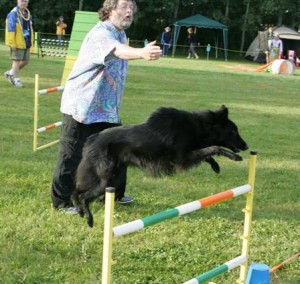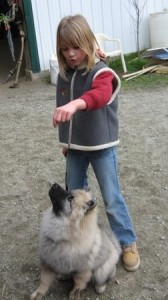 Dogs have been with us for centuries. Today, millions of dogs live in the homes of humans. But what exactly is the dog getting out of the deal? In fact, a better question is what should the dog be getting out of the deal?
Dogs have been with us for centuries. Today, millions of dogs live in the homes of humans. But what exactly is the dog getting out of the deal? In fact, a better question is what should the dog be getting out of the deal? ![]()
People get dogs for all kinds of reasons, some good and some bad. For some people, bringing a dog into their lives can heal a broken heart. The dog gives them something to care for, to feel attached to, to feel connected with. Other people enjoy dogs for social experiences such as taking their dogs to dog shows, training classes or competitions, and enjoying the company of other dog-loving humans and their dogs. Still others enjoy the company of a companion who doesn’t judge, always listens, and is there when you need someone to just be there.
Our Side of the Bargain
Dogs give us a lot. We find tremendous value in them whether that value is as profound as being a “true companion” in their lives or as mundane as a being guard dog to alert you that someone is in the yard.
We ask a lot of dogs. Anyone who has ever felt uplifted, laughing as a baby pulls at the ears and whiskers of the family dog, is witnessing something of a miracle. That kind of restraint in the face of obvious discomfort demonstrates how far that dog is willing to go for her human family. If you have ever had the chance to watch dog sports like Schutzund or Dog Agility, you have seen dogs using their instinctive behaviours in new and creative ways at the direction of their human handlers, with incredible precision.
We ask dogs to help the sight-challenged navigate their lives. We ask dogs to help us find lost children doing search and rescue. Dogs are employed for the most grisly of tasks, such as finding the cadavers of those not lucky enough to survive disasters like 9/11. And somehow they are always there for us. They are always ready to try any task we set them to.
Their Side of the Bargain
In return for their loyalty and efforts, what do we give our dogs? Well, certainly, there are the basics: food, water, a place to sleep, and some degree of security. Even these will vary from situation to situation. There are outdoor dogs and indoor dogs. There are dogs who eat better than some humans and others who get what’s on sale at the local grocery store. There are some that spend hours on end alone each day, and others who rarely leave their human’s side.
 While there are extreme instances where dogs are bought and sold as commodities, and stories of “puppy mills” housing sometimes more than a hundred dogs in deplorable conditions, most dogs live decent lives. But as our understanding of the inner lives of dogs and their capabilities is expanding, do we owe it to them to look beyond these basics and look at what else we need to provide our dogs?
While there are extreme instances where dogs are bought and sold as commodities, and stories of “puppy mills” housing sometimes more than a hundred dogs in deplorable conditions, most dogs live decent lives. But as our understanding of the inner lives of dogs and their capabilities is expanding, do we owe it to them to look beyond these basics and look at what else we need to provide our dogs?
The Good Life
In the 1960s, the British government commissioned a study to determine what a “good life” for domesticated animals should be. By this, they did not mean to examine the animal’s physical welfare, but their mental lives. Out of this study came a report by the Brambell Committee which defined “The Five Freedoms” that should be afforded to domesticated farm animals.
These freedoms were defined as:
- freedom from hunger and thirst
- freedom from discomfort
- freedom from pain, injury, or disease
- freedom to express normal behaviour (for their species)
- freedom from fear and distress.
On the face of it, these freedoms seem simple, obvious and easy to achieve. But if we look closer, some of these “freedoms” can get a little foggy as we consider our daily lives with our dogs.
For example, how does the use of an electronic “shock” collar square up with a dog’s “freedom from discomfort”? How does a forceful reprimand or “bark collar” stack up with a dog’s “freedom to engage in normal behaviour”? And this is to say nothing of the even less clearly defined “freedom from fear and distress.” If we don’t take the time to know what frightens or distresses our dogs, are we relieved of the burden of providing for this particular “freedom?”
Another Look at “The Deal”
By and large, our dogs lives are dictated by our convenience. The choice to have dogs in our lives is in itself dictated by our own motivations for bringing them into our homes. It’s a rare thing that dogs seek out particular places to live or are careful in their choices of which home would be best for them. How and if a dog lives with us is based on our hopes and desires for that relationship.
As far as the Brambell Committee’s “Five Freedoms” go, that first one — “freedom from hunger and thirst” — is pretty well covered. No one really enjoys a dead dog so food and water are pretty well attended to. Things start to get a little more sketchy at Freedom #2 which is “freedom from discomfort.” Do most owners take the time to know what makes their dogs uncomfortable? I hope so. But I have seen even simple examples of not abiding by this freedom: picking up a dog that clearly doesn’t like it, or bending over a dog that is clearly uncomfortable with strangers. Do we have an obligation to keep our dog from these uncomfortable and sometimes distressing situations?
The third freedom — “freedom from pain, injury, or disease” — becomes even more difficult. Is the dog given the best medical care? Is the dog vaccinated? Is the dog kept in an environment where he cannot injure himself? Is he reprimanded or disciplined in a way that involves physical contact — and is that contact potentially painful or hard enough to potentially cause injury?
The fourth freedom — “freedom to express normal behaviour” — seems like a paradox in some situations. Dogs bark because at some point humans selectively bred them for this trait, yet many of us punish them for barking. Sniffing is just part of being a dog and yet many humans get annoyed with them taking too much time sniffing on walks. Chewing is a natural stress release for dogs and is part of their natural behaviour system and yet many owners don’t provide “safe” objects for their dogs to chew and get angry when their dogs chew on shoes or furniture.
The freedom from “fear and distress” is perhaps the most poorly defined, and the hardest to pin down. It can be difficult from our human perspective to understand what may seem frightening or distressing to our dogs. We may laugh at the dog who seems panicked, snarling and barking at the sight of a new refrigerator or vacuum cleaner. But the fear the dog feels is real. Learning to recognize signs of fear and stress should be basic to dog ownership, but sadly this doesn’t seem to be the case.
How can we give our dogs a “fair deal” in their lives with us? Can we use these “Five Freedoms” as a basis to examine our relationship with our dogs and perhaps improve things for both dogs and humans?
In our home, we think of this as creating a contract with our dog. We establish a set of promises that we will live up to, as well as boundaries and behaviours we will expect of our dog.
We have a few simple things we set down as “rules”. This “contract” becomes the framework for training, living with, and playing with our dogs. Here are some examples from our “contract” with our dogs:
Train It or Manage It – This is a promise to ourselves about how to deal with our dogs’ behaviour. If they have behaviours we don’t like, or if they don’t have behaviours that we want, it is our job to teach these behaviours to our dogs, or to manage their situation so they don’t have an opportunity to do the “wrong” thing. A simple example of training is that we ask our dogs to always carry a ball while running with each other in play so there is no accidental nipping to cause unnecessary scuffles. An example of management is that we use baby gates in our home to make sure that our dogs don’t go into areas unsupervised. We don’t have to teach our dogs that certain objects are off limits because they never have access to them without us present.
Never Lie to the Dog – This might seem obvious, but you would be surprised at how often people trick their dogs into doing things by offering a cookie that never gets delivered. Since we teach our dogs using Mark and Reward training, our dogs get paid with a reward each time they hear the marker that signals they have done the correct behaviour. In a sense, that marker is a promise that payment is coming, whether that reward is food or play or access to the backyard. Never lying to our dogs means that we always deliver what we promise; “mark” means “reward”. And this carries over to other things in life. No tricks and no promising cookies to lure the dog to do things if we don’t have cookies with us. This builds a simple bond that our dogs can trust our behaviour. We say what we mean and we mean what we say.
Let dogs be dogs – This might sound like it could create havoc, but it is more of an attitude than an action. For example, a new puppy who eliminates in the house is just doing what dogs do. She didn’t relieve herself on the carpet to upset me, she is being a dog. Shame on me for not recognizing that she needed to go and helping her do it in the right place. Similarl,y when my young dog starts running around the house looking for things to get into, that’s a clear signal that he needs some time outside to run around as young dogs need to do. It’s on me to recognize that and to make sure that happens. Letting dogs be dogs means not punishing them for their natural inclinations and making sure they have outlets for those needs that are convenient for both of us.
No Surprises – This is one that has helped us tremendously with our dogs. We try to create information signals whenever we can to help our dogs know what’s coming next. Many dog owners will clearly signal when it’s time for dinner or a walk, but we go a bit further. For example, if I get up to get a glass of water, I tell my dogs “I’ll be right back” so they know there is no reason to follow me. If I am eating something and my dog wants to sniff, I warn her by saying “Not for you.” So she knows that this is not something she is going to eat. On our walks, I always say “Let’s go” before moving on and yanking on the leash so she knows to stop sniffing and to come along. In this way, we keep our dogs informed so there are no surprises.
A Fair Shake
There are a few other things we “write into our contracts” with our dogs, and it’s all in a spirit of fairness. We ask more of our dogs than many other dog owners. We enjoy herding, dog agility, tracking, and lots of social activities. That requires our dogs to be very flexible about simple things like meal times and being in new and different environments. We ask them to take it in stride, and to be in the van for hours at a time to get to places. And we expect them to have good manners with new people and strange dogs.
 So our contract with them tries to focus on those “Five Freedoms” and to assure them of a relatively stress-free life. We try to make sure that we teach them the things they need to know to be successful in the life they live with us. In those cases where we can’t teach them what we need, we manage their situations to minimize their stress or any threat to their safety.
So our contract with them tries to focus on those “Five Freedoms” and to assure them of a relatively stress-free life. We try to make sure that we teach them the things they need to know to be successful in the life they live with us. In those cases where we can’t teach them what we need, we manage their situations to minimize their stress or any threat to their safety.
It’s important to us to never punish our dogs for being dogs. Each time they surprise us by behaving in a way we don’t like, we try to examine what happened from our dog’s perspective. And then we go back to our contract to “Train it or Manage it.” Is there a way to train an alternative behaviour in that situation? Or do we just need to do a better job in managing things to make sure our dog doesn’t have the opportunity to do that behaviour again?
It’s so easy to forget that dogs are dogs. They are so attuned to who we are as humans, and that’s not by accident. By and large, we have made them that way. But they deserve every opportunity to be successful. As the Brambell Committee’s report showed in 1965, we have a responsibility to care for the domesticated animals we bring into our lives and provide for their basic needs, both physically and mentally.
Our understanding of dogs is evolving quickly. Today, we know more about the capabilities of dogs than ever before. The days where dogs learn by trial and error should be over because we now have the tools to teach them to succeed with very little effort.
We love our dogs. Doesn’t it make sense to make sure that they get a fair deal in our homes? I’m sure you all have your own contracts. Take a few minutes to list all of the promises you make to your dog to keep him or her healthy and safe. I’m sure you’ll be pleasantly surprised at how good your dog has it. And if you find a few gaps in there, maybe this is a great time to add a few things in to make your relationship with your dog even better. Thank heavens dogs can’t hire lawyers.
Until next time, have fun with your dogs!
Photo Credits
All photos copyright © Petra Wingate, 2006-2011





I love this piece. It beautifully clarifies not just what our obligations are, but what it means to be good human companion for a dog. Thank you! And I love the contract idea too. My yellow lab has recently become afraid of thunder. I don’t know how to comfort her except that she feels safest in the walk-in shower. So whenever there is thunder, I make sure the door to the shower is open for her. Sometimes she gets more comfort by being close to me so I just make myself as available to her as she needs. Just an example of how I feel obligated to meet her needs.
Hi Sophie,
There is a great product called Thunder Shirt that helps with anxiety – I used it for my senior dog, Molly, and it dramatically reduced her stress during storms as well as during fireworks and vet appointments. I have heard good feedback from others, too.
http://www.thundershirt.com
Cheers,
Amanda